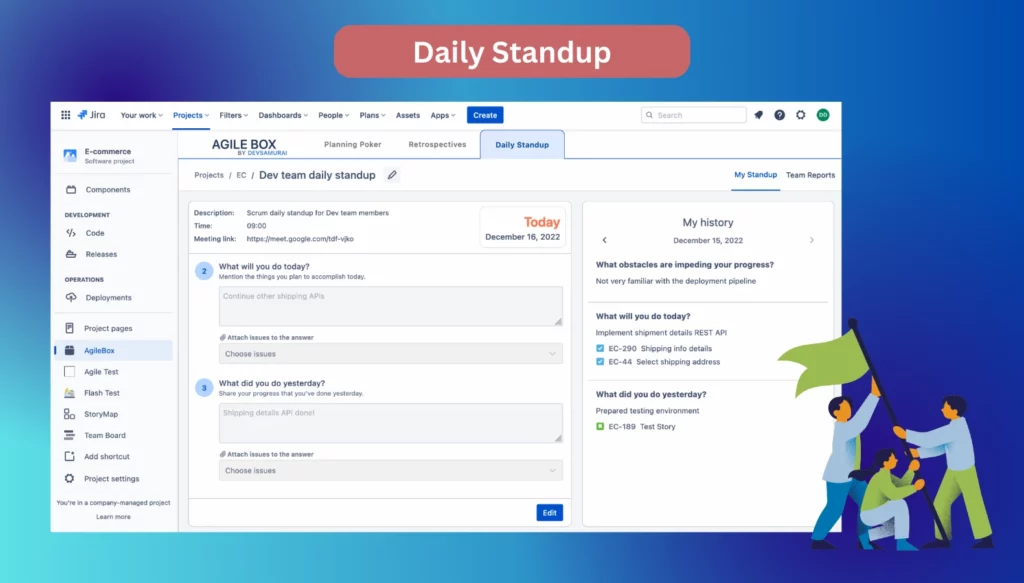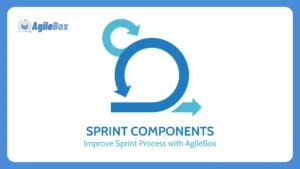Introduction
A daily standup meeting, or a daily scrum, is a brief meeting held by a development team, usually at the beginning of each workday. During the meeting, team members provide updates on their progress since the last meeting, discuss any obstacles they face, and identify any action items they need to complete before the next meeting.
The meeting is typically short, ranging from 10-15 minutes, and is intended to keep the team aligned and focused on their goals. The name “standup” comes from the tradition of holding the meeting standing up to keep it short and to the point. Daily standup meetings are vital to the Agile methodology, emphasizing collaboration, flexibility, and responsiveness to change.
Purpose of Daily Standup

A daily standup meeting, or daily scrum, enhances communication, collaboration, and productivity in the development team. The meeting has three primary objectives:
- Status Update. Team members provide a brief update on their progress since the last meeting, including what they accomplished, what they plan to do next, and any obstacles or issues they face. This helps ensure that everyone is informed about the project’s progress.
- Coordination. The daily standup ensures team members are aligned with project goals and priorities. By sharing progress and obstacles, the team can coordinate their efforts to ensure the project is on track and everyone works efficiently.
- Problem-Solving. The daily standup also allows the team to identify and resolve any issues or blockers that impede progress. By identifying problems early on, the team can work together to find solutions and prevent them from becoming more significant problems.
The daily standup promotes transparency, collaboration, and accountability within the development team. The daily standup ensures that the team works efficiently and effectively to deliver high-quality software on time and within budget by keeping everyone informed and aligned with project goals.
Benefits of Daily Standup Meetings

Daily standup meetings provide numerous benefits to development teams, including:
- Improved Communication and Collaboration. Daily standup meetings facilitate regular and open communication between team members, allowing them to stay informed about project status and progress. This helps to improve collaboration and teamwork.
- Increased Transparency. Daily standup meetings increase transparency within the team by sharing progress and blockers. This allows team members to see what everyone else is working on and how their work fits into the project. This can help to improve trust and accountability within the team.
- Better Alignment with Project Goals. Daily standups help keep the development team aligned with project goals and priorities by providing regular updates on progress and goals. This ensures that the team works efficiently and effectively to deliver the required software within the timeframe.
- Early Identification and Resolution of Issues and Blockers. Daily standup meetings help identify any issues or blockers before they become significant problems. This allows the team to work together to find solutions and prevent delays, leading to more efficient and timely project delivery.
- Enhanced Productivity and Efficiency. By keeping everyone informed and aligned with project goals, daily standups help improve productivity and efficiency. This ensures that the team works on the most critical tasks and that everyone works together to deliver high-quality software on time.
- Improved Team Morale. Daily standup meetings help to create a sense of community and purpose within the development team, promoting better team morale and job satisfaction.
These meetings help ensure that development teams work collaboratively and effectively to achieve project goals. Daily standups can help enhance productivity, efficiency, and overall project success by promoting regular communication, transparency, and accountability.
Best Practices for Daily Standup Meetings
Here are some tips for running effective daily standup meetings, as well as some common pitfalls to avoid:
Tips for Effective Daily Standup Meetings:
- Keep it short and focused. Limit daily standup meetings to 15 minutes to keep everyone engaged.
- Start and end on time. Being punctual is crucial for daily standups to ensure everyone can attend and participate.
- Use a consistent format. A standard format like “What did I do yesterday? What will I do today? What are my blockers?” can help keep the meeting on track.
- Encourage everyone to participate. Encouraging participation ensures everyone is informed and potential blockers are identified early on.
- Avoid getting bogged down in details. Daily standups are not for detailed discussions or problem-solving; save those for later meetings.
- Follow up on action items. After each daily standup, promptly address any action items to keep the team on track.
Common Pitfalls to Avoid in Daily Standup Meetings:
- Avoid going off on tangents. Keep the discussion focused on progress and blockers.
- Avoid turning them into status reports. Daily standups should not be used for status updates but for quick progress updates and issue identification.
- Avoid wasting time. Ensure daily standups are productive and efficient by making any necessary changes.
Daily standup meetings can be a valuable tool for improving communication, collaboration, and productivity within the development team by following these tips and avoiding these common pitfalls.
Using Daily Standup Meetings for Jira with AgileBox
Daily standup meetings continue to play a crucial role in Agile development teams nowadays. With the rise of remote work, teams must find ways to conduct these online meetings.
One solution is AgileBox, a Jira application with a Daily Standup feature. This tool allows Agile teams to hold their daily standup meetings remotely, keeping everyone on the same page without needing physical “standup” meetings.

There are some additional features for the Daily Standup by AgileBox, including:
- Automate Daily Standup. Schedule meetings for a routine. Easily schedule meetings for your team daily or weekly, depending on your needs.
- Browse Standup History. Keep all the meeting records for future reference. Browse through previous meetings and track the progress of your team over time. Identify areas of improvement and track your team’s progress toward your project goals.
- Report Quick and Easy. Your team can easily report in the form by answering the questions created in the meeting setup. These questions could be changed at any time without creating a new meeting.
- Get the related Issues. By attaching issues to your answers in the report form, your team can easily catch up with which task you mention and your progress.
In summary, daily standup meetings are still crucial for Agile development teams, even in the age of remote work. AgileBox is a Jira application that provides a Daily Standup feature, enabling teams to hold these meetings remotely and keep everyone on the same page.
Conclusion
Daily standup meetings are essential in Agile development teams to improve communication, collaboration, productivity, and project success. The daily standup promotes transparency, accountability, and teamwork within the development team. AgileBox, a Jira application, offers a Daily Standup feature, which provides additional benefits such as automating meetings, browsing standup history, prompt reporting, and related issues. Daily standups help ensure that development teams work efficiently and effectively, even in remote work environments.



